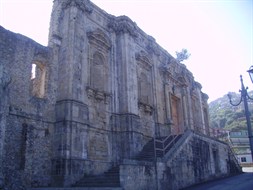Serra San Bruno and Soriano Calabro
Two places of great importance in the devotional and spiritual history of Calabria in the early modern period are the chapter house of Santo Stefano del Bosco at Serra San Bruno, and the Dominican convent at Soriano Calabro. Serra San Bruno was founded by the Normans, yet its urban structure goes back to the Baroque period. Repeatedly chastised by seismic events which obliged the repair, if not the outright rebuilding of some of its monuments, Serra San Bruno conserves some of the vestiges of Baroque art in the mother church, the church of the Addolorata or of Maria Santissima dei Sette Dolori, that of the Assunta and of Santa Maria del Bosco and in the Pisani palace. The chapter house of Santo Stefano, which flourished in the early modern period, was also completely destroyed by the earthquake of 1783 and rebuilt in a Neogothic style.
 In Soriano Calabro, the local Dominican convent was placed under the direct protection of the sovereigns of Spain and, in the same period, it attained a noteworthy level of economic power in addition to obviously being culturally and religiously influential. Thanks, in fact, to the bequeathals, donations and the offerings of the many pilgrims who arrived there on account of the miraculous image of the Dominican saint which it housed, the convent acquired a vast estate. A great number of clergy and lay people went there to pursue studies in Theology and Philosophy among other disciplines, such as courses in oriental languages, which were instituted there in 1622. The greatest demonstration of the power and wealth of the convent was that of 1652, when the friars acquired the fief of Soriano for 84.000 ducats, which had remained vacant after the death of the last Carafa, the feudatories. Seriously damaged by the earthquakes of 1638 and 1659 and even more by that of 1783, the convent was only rebuilt in part and there still are ruins of the original one.
In Soriano Calabro, the local Dominican convent was placed under the direct protection of the sovereigns of Spain and, in the same period, it attained a noteworthy level of economic power in addition to obviously being culturally and religiously influential. Thanks, in fact, to the bequeathals, donations and the offerings of the many pilgrims who arrived there on account of the miraculous image of the Dominican saint which it housed, the convent acquired a vast estate. A great number of clergy and lay people went there to pursue studies in Theology and Philosophy among other disciplines, such as courses in oriental languages, which were instituted there in 1622. The greatest demonstration of the power and wealth of the convent was that of 1652, when the friars acquired the fief of Soriano for 84.000 ducats, which had remained vacant after the death of the last Carafa, the feudatories. Seriously damaged by the earthquakes of 1638 and 1659 and even more by that of 1783, the convent was only rebuilt in part and there still are ruins of the original one.
